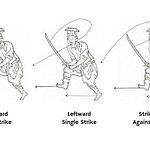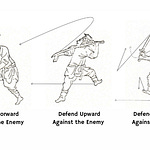Before executing any defense technique, establish a proper guard stance:
Feet positioned in ‘Empty Stance’ with weight evenly distributed
Knees slightly bent for mobility
Sword held at middle height, tip slightly higher than solar plexus
Body angled 45 degrees to present a smaller target
Core Defense Techniques
1. Upper Block (Cauldron-Lifting Block)
Designed to defend against overhead attacks:
Raise the sword horizontally above the head, gripping slightly higher on the handle than the blade.
Keep elbows slightly bent for flexibility and shock absorption.
Angle the blade slightly forward to effectively deflect the force of the incoming strike.
Counter Opportunity: Transition smoothly by stepping forward while bringing the blade down into a counter-attack.
2. Middle Block (Chariot Reins Block)
Effective for intercepting diagonal and linear attacks:
Lead with the dominant hand to generate power while moving diagonally to intercept the attack.
Maintain a slight blade angle to deflect the force rather than absorbing it directly.
Use a continuous circular motion to deflect and redirect the opponent's weapon, conserving energy with minimal movement.
Particularly effective against straight thrusts.
Counter Opportunity: Flow seamlessly from the deflection into a rising cut, exploiting the opponent's opening.
3. Spin Block (Spinning Wind Block)
A dynamic defense for aggressive, multi-directional attacks:
Execute a full 360-degree spin while maintaining a diagonal blocking angle to cover multiple attack lines.
Follow the spin with two quick, controlled steps forward to close the distance, neutralizing the reach advantage of long weapons like spears.
Counter Opportunity: Upon closing the gap, apply a combination of quick strikes targeting exposed areas, capitalizing on the opponent's disrupted stance.
These core defense techniques not only neutralize threats but also create fluid transitions into offensive actions, maintaining the rhythm and flow essential in combat.
Training Methods
Solo Practice
Practice blocks in sequence: high, middle, low, diagonal
Focus on proper blade angles
Incorporate footwork with each block
Practice transitioning between blocks
Add counter-attacks to create combinations
Partner Drills
Begin with slow, choreographed attacks
Gradually increase speed as coordination improves
Practice reading attack angles
Focus on deflection rather than direct blocking
Work on timing counter-attacks
Tactical Considerations
Economy of Motion
Minimize blocking movement to conserve energy
Focus on deflection rather than forceful blocking
Target opponent's weapons hand when counter-attacking
Battlefield Context
Unlike Japanese Kendo, which evolved from dueling traditions, Korean sword techniques typically anticipate battlefield situations;
Quick, efficient movements
Multiple opponent scenarios
Varied weapon encounters
Practical disarming techniques
Conservation of energy and minimal damage
Advanced Concepts
Every block should set up a counter-attack
Use opponent's force to aid your counter
Look for opportunities to disable opponent's weapon hand
Counter-attacks should flow naturally from defensive positions
Close distance against longer weapons
Create space against shorter weapons
Use footwork to control engagement range
Safety Notes
Always practice with appropriate training weapons
Begin slowly and increase speed gradually
Focus on control rather than power
Maintain awareness of training partners
How do you like our video’s so far? Any questions or feedback?
Let us know in the group chat. Feel free to leave your comments here:
















Share this post